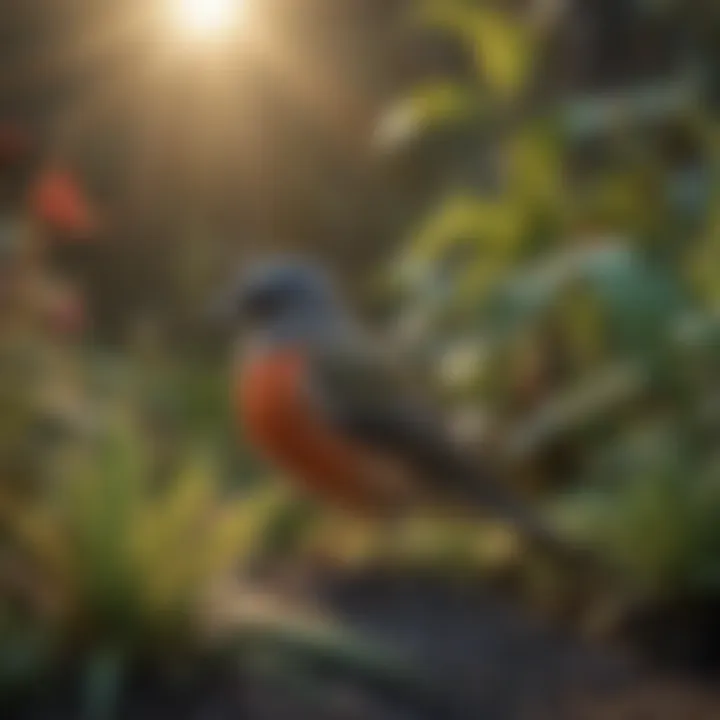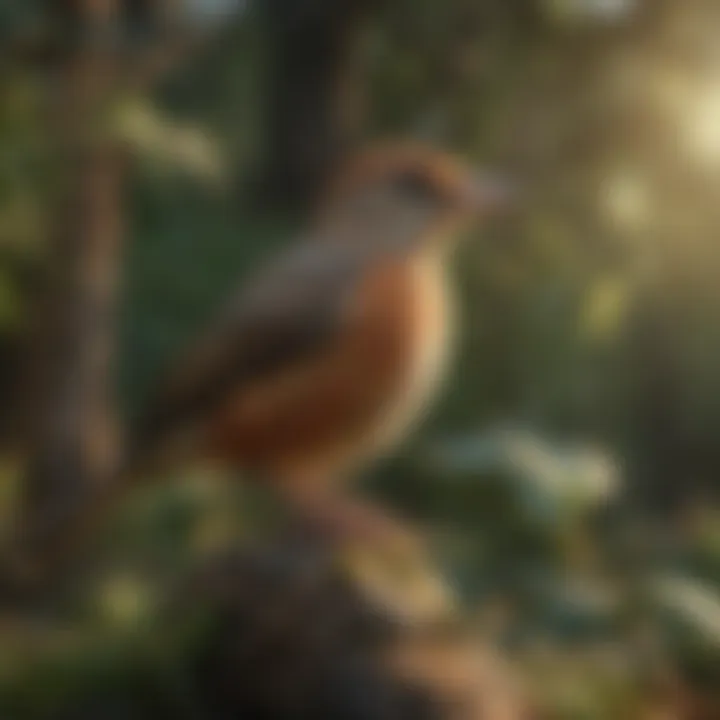Effective Strategies for Managing Birds at Home


Intro
Birds can be delightful in their natural habitats, but when they start invading residential areas, the situation changes dramatically. These avian creatures can cause significant disturbances. Their droppings can lead to unsanitary conditions, and nesting activities might damage property. Identifying effective strategies for managing bird populations becomes essential for homeowners.
In the following sections, we will explore various aspects of managing birds effectively and humanely. From identifying common bird pests to prevention strategies and ethical treatment options, this guide aims to equip homeowners with knowledge and tools necessary for a balanced coexistence with local bird populations.
Understanding the Challenges of Birds Near Homes
Birds occupy various roles in urban ecosystems. Their presence, while often appreciated, can also lead to several challenges for homeowners. Understanding these challenges is crucial in effectively managing bird populations without harming them or disrupting the environment.
Common Bird Species Found in Urban Areas
Different bird species adapt well to urban settings. Common examples include:
- Pigeons: Often found in city squares and parks, they thrive in places with abundant food.
- Sparrows: These small birds are adaptable and often reside near buildings and gardens.
- Starlings: Known for their noisy flocks, starlings can create disturbances around homes.
- Crows and Ravens: They are intelligent birds and can scavenger, leading to issues with waste.
Homeowners should be aware of local bird species and their behaviors. This knowledge helps in implementing effective management strategies.
Potential Issues Caused by Birds
Birds, while fascinating, can lead to various problems for homeowners and the environment:
- Property Damage: Nesting in gutters or on roofs can lead to significant damage. The build-up of nesting material can cause blockages and water damage.
- Health Concerns: Bird droppings can harbor diseases. Prolonged exposure can affect family health, especially for those with allergies or respiratory issues.
- Noise Pollution: Large populations of certain species can create excessive noise, disrupting peaceful living conditions.
Being aware of these potential issues prepares homeowners to take proactive measures.
Legal Considerations in Bird Management
Managing birds also involves understanding legal implications. Various laws protect certain species, making it essential to handle bird issues humanely. Awareness of relevant laws reduces the risk of legal consequences when addressing bird problems.
"Understanding local wildlife laws is essential for responsible bird management."
Actions such as removing nests or trapping birds can violate protections established by wildlife regulations in many regions. Before taking steps to manage these populations, homeowners should:
- Research the local wildlife protection laws.
- Consider consulting with wildlife specialists to ensure compliance.
- Explore humane alternatives that align with legal standards.
In summary, understanding the challenges posed by birds near homes lays the foundation for effective management. Awareness of local species, potential issues, and legal considerations will empower homeowners to mitigate conflicts while respecting the environment.
Assessing Your Property for Attractants
Understanding the factors that attract birds to your property is crucial for effective management. A thorough assessment allows homeowners to identify and subsequently modify elements that may entice birds to settle. By doing so, you can significantly reduce the likelihood of bird-related issues, such as noise disturbances and property damage.
Identifying Suitable Nesting Areas


Birds seek safe and suitable spaces for nesting. Signs of nesting can include twigs or feathers near potential shelters. Common areas might be eaves, attics, or dense foliage. To identify these spots, inspect your property carefully, particularly during the breeding season. Remove or alter these potential nesting sites to deter birds from taking residence. For example, installing metal mesh to block entry can be effective here.
Evaluating Food and Water Sources
Birds require food and water to thrive. Your property might provide these essentials unwittingly. Leftover pet food, bird feeders, or unharvested crops can be attractions. Regularly check food sources and minimize wasted food around you. Additionally, stagnant water sources can also attract birds. Consider removing these to limit their presence. If moisture is necessary for plants, ensure that it drains adequately.
Impact of Landscaping Choices on Bird Presence
Your landscaping choices play a significant role in bird presence. Certain plants attract birds more than others, especially berry-producing shrubbery. If your aim is to deter birds, consider landscaping with shrubs that have thorny branches or those that produce less fruit. Moreover, maintaining your garden by trimming overgrown areas can reduce cover, thus making it less appealing for birds to settle.
Remember, a well-kept yard can minimize not only the chances of birds nesting but also pests that may accompany them.
By systematically assessing these elements, you gain control over your environment. This proactive approach helps keep undesirable bird populations at bay, ensuring a more harmonious home.
Preventative Measures to Discourage Birds
Managing bird populations near residential areas involves several preventative measures that can dramatically reduce their presence. These techniques help protect property and maintain sanitation. Understanding these measures is essential for homeowners who wish to create an environment that discourages birds without causing harm.
Habitat Modification Techniques
One of the first steps in preventing birds from frequenting your property is modifying their habitat. By making certain areas less appealing, you can effectively lessen the likelihood that birds will settle nearby. This can include:
- Eliminating Dense Shrubberies: Birds tend to favor well-protected nesting areas. If you have dense shrubs, consider trimming or removing them to reduce nesting sites.
- Changing Landscaping Choices: Opt for plants that produce little to no fruit or seeds, as these attract birds looking for food.
- Maintain Cleanliness: Regularly rake up fallen fruit, seeds, and other organic debris that may serve as a food source for birds. Keeping your yard clean limits their access to snacks.
These modifications not only help in bird deterrence but also improve the aesthetic appeal of your space.
Effective Use of Visual Deterrents
Visual deterrents can be a highly effective way of keeping birds at bay. Utilizing objects that reflect light or create confusing motions can discourage them from entering or staying in your property.
- Reflective Objects: Items such as aluminum foil strips or reflective tape can be hung in trees or along fences. These materials reflect sunlight and create an unsettling environment for birds.
- Decoys: Placing decoys like owl statues can help create a sense of danger, making birds think that potential predators are nearby.
- Kites and Wind Socks: These can replicate bird movements when the wind blows. Their fluttering can disturb and scare birds away from your yard.
Visual deterrents are noteworthy because they are non-invasive and can be easily removed or replaced, allowing for flexibility in your approach.
Acoustic Deterrents as a Solution
Sound can also serve as a powerful deterrent for birds. By introducing noises that are unnatural for birds, you can effectively encourage them to relocate. Consider the following options:
- Predatory Bird Calls: Devices that emit calls of predatory birds can create a natural fear among smaller birds. These sound systems can be programmed to operate at various times during the day.
- Ultrasonic Repellers: These gadgets produce sound waves that are inaudible to humans but annoying to birds. While this is a more technological approach, it can be effective in larger spaces.
- Random Noise Makers: Things like wind chimes or even motion-activated noise-making devices can confuse birds and discourage them from staying too long.
Application of acoustic deterrents should be done carefully to avoid disturbing neighbors and keeping the sound level moderate.
Implementing Physical Barriers
Finally, one of the most direct ways to prevent birds from accessing certain areas of your property is through physical barriers. These barriers ensure that birds cannot land or nest in areas where they are problematic.


- Bird Netting: Installing fine mesh netting around fruit trees or gardens prevents birds from getting to fruits and vegetables.
- Spikes and Strips: These can be placed along ledges, roofs, or railings. They act as a physical deterrent without harming birds.
- Fencing and Covers: Secure your garden with fencing that limits bird access. You can also use mesh covers for sandboxes or uncovered areas.
Physical barriers are an effective solution for property management since they directly address the issue at hand without causing harm.
"The best management strategy is one that builds a harmonious relationship between homeowners and nature."
Natural and Chemical Repellents
Managing birds around residential areas requires understanding various strategies. Natural and chemical repellents represent a critical component in this approach. Their purpose is to deter birds from specific locations without causing them harm. This ethical aspect is essential for homeowners who want to maintain a harmonious coexistence with nature while protecting their property.
Benefits of Using Natural and Chemical Repellents
Natural repellents often pose fewer health risks to humans and pets compared to chemical options. They can be derived from plant-based ingredients or other non-toxic substances. Chemical repellents, though effective, may require careful consideration regarding their application and potential environmental impact. Strategies that utilize both methods can address different bird behaviors effectively. By employing these repellents, homeowners can safeguard their properties from damage while also adhering to humane practices.
Overview of Natural Repellents
Natural repellents encompass a range of materials or methods designed to dissuade birds without harm. One of the most recognized types includes
- Predator Scents: The presence of materials that mimic the scent of predatory animals can effectively scare away small birds.
- Citrus Oils: Essential oils, such as lemon or orange, often repel birds due to their strong aroma. Spraying these oils in targeted areas may minimize bird presence.
- Garlic and Pepper Solutions: Mixtures containing garlic or hot pepper can deter birds when applied to surfaces where birds frequently gather.
The efficacy of these products can vary based on local bird species and environmental conditions.
Evaluating Chemical Options for Bird Control
Chemical repellents can be effective for serious situations where birds cause significant damage. Products are available in liquid or granular forms. It is vital to choose chemicals that are specifically designed for bird control.
Common options include:
- Methyl Anthranilate: This substance is derived from grapes and is known to deter birds without being harmful to them. It interrupts their feeding and nesting habits.
- Bird B-Gone: This product helps to create a barrier that birds find unappealing, redirecting their movements away from treated areas.
However, care must be exercised when using chemicals around pets or children. Homeowners should follow label instructions carefully and ensure that application methods do not accidentally harm non-target species.
Combining Strategies for Maximum Effectiveness
Utilizing both natural and chemical repellents together can enhance control measures significantly. This combination can address various bird species and situations.
- Layering Techniques: Apply natural repellents first, followed by chemical solutions where necessary. This approach can produce immediate results while developing longer-term deterrents.
- Monitoring Effectiveness: After implementation, observe the changes in bird activity. Adapting strategies based on observed outcomes will allow homeowners to refine their approaches over time.
- Considering Seasonal Variations: Different seasons may prompt varying bird behaviors. Adjusting strategies accordingly can improve effectiveness.
By integrating these methods into a comprehensive strategy, homeowners can navigate the challenges posed by birds effectively and ethically.
Monitoring Bird Activity Around Your Home
Understanding bird activity around your home is crucial to effectively managing avian populations. Monitoring provides clear insights into the types of birds that visit your property, their behavior patterns, and the specific attractants present. This information can help homeowners devise tailored strategies, minimizing potential nuisances and property damage. Additionally, consistent monitoring offers the chance to assess the effectiveness of implemented measures and adjust them accordingly.
Establishing a Monitoring Plan
Creating a robust monitoring plan is essential. Begin by determining specific goals: do you want to reduce bird numbers, protect your garden, or simply observe their behavior? Start with regular observation sessions at different times of the day and varying weeks to gather comprehensive data.


- Identify observation points: Choose strategic locations from where you can comfortably view bird activity. This might include windows, porches, or your garden.
- Record observations: Maintain a simple log detailing the dates, times, and specific bird species observed. This habit can reveal patterns, such as seasonal changes in bird populations.
Developing a monitoring schedule ensures that your observations are systematic and can lead to better-informed decisions on management strategies.
Using Technology to Assist in Monitoring
Technology can significantly enhance monitoring efforts. Various tools can simplify collecting data and provide additional insights.
- Smartphone apps: Consider apps like Merlin Bird ID or BirdNet, which can help identify bird species through sounds or images.
- Cameras and birdhouses: Installing cameras can allow for remote observation. Birdhouses with integrated cameras can offer a unique glimpse into nesting habits and behaviors.
- Hearing devices: Sound recorders can capture bird calls, enabling identification and monitoring of species that might be difficult to see.
Utilizing these technologies not only streamlines monitoring but also enriches your understanding about local birdlife.
Regularly monitoring can reveal trends that inform both short-term and long-term strategies for managing birds near your home.
When to Seek Professional Assistance
Managing bird populations around your home can become a complex task. Homeowners may successfully implement various strategies but sometimes require extra support. Understanding when to seek professional assistance is essential. This section explores the reasons why professional help may be necessary and the benefits it provides.
Identifying Persistent Problems
Bird-related issues may start small but can escalate over time. If a homeowner notices consistent problems despite implementing standard preventive measures, it may be time to consult with an expert. Some signs of persistent problems include:
- Ongoing Property Damage: Repeated signs of nesting or pecking at structures can indicate that birds are not just passing through. They may be looking for secure areas to build nests, which can cause significant harm to roofs and eaves.
- Health Risks: Fecal droppings can lead to unsanitary conditions, posing health risks to family members. Diseases transmitted by birds such as histoplasmosis could surface if droppings are not managed.
- Behavioral Changes: Noticing that birds are becoming more aggressive or are expanding their presence in undesirable areas may signal that a larger problem exists.
Taking note of these factors can provide vital insight into whether professional intervention is necessary.
Benefits of Professional Intervention
Consulting professional pest control specialists has numerous advantages. They bring expertise and resources that can effectively address complex bird management issues. Key benefits include:
- Customized Solutions: Professionals can evaluate a property and tailor strategies to address specific problems. They understand local bird behaviors and habitats better than an average homeowner.
- Access to Specialized Tools: Many effective solutions require specialized equipment or substances that may not be readily available for public use. Professionals can deploy methods that are both effective and compliant with local regulations.
- Long-Term Control: Preventative measures enforced by professionals often yield long-term results. They help to ensure that solutions are sustainable and minimize the chances of recurring issues.
- Time and Effort Savings: Managing birds can be time-consuming. Hiring experts allows homeowners to focus on other responsibilities while effectively managing avian challenges.
Seeking professional help can transform a daunting task into a manageable one, providing peace of mind and effectively safeguarding your home.
Ends and Best Practices
Understanding the various strategies for managing birds near homes is essential for homeowners. This section synthesizes key strategies while emphasizing the significance of thoughtful, humane practices. It is crucial to remain proactive in addressing bird-related issues. By implementing effective management techniques, you protect your property, maintain a clean environment, and ensure cohabitation with wildlife in a respectful manner.
Recap of Effective Strategies
Bird management encompasses a variety of tactics aimed at discouraging unwanted avian visitors. The foremost strategies include:
- Preventative Measures: Modify the environment around your home to be less inviting for birds. This includes reducing potential nesting sites and managing food sources.
- Natural and Chemical Repellents: Use natural substances like vinegar or cayenne pepper, or explore eco-friendly chemical options that deter birds without causing them harm.
- Visual and Acoustic Deterrents: Incorporate reflective materials or devices that create sounds to scare birds away. This can be particularly useful in areas known for bird congregation.
- Physical Barriers: Installing netting or spikes can directly prevent birds from accessing specific areas, such as roofs and ledges.
By employing a combination of these techniques, homeowners can effectively manage bird presence while promoting a safe living environment.
Continual Assessment and Adaptation
Managing birds is not a one-time effort; it requires ongoing attention and adaptation. As environmental conditions and bird behaviors change, so too should your strategies. Regularly assess your property to determine if adjustments are needed.
- Monitoring Bird Activity: Establish a simple monitoring plan to observe bird patterns around your home. Keep records of any increased activity during particular seasons or times.
- Evaluating Efficacy: Regularly assess the effectiveness of the strategies in use. If birds persist, re-evaluating and modifying your approach is vital.
- Educating Yourself: Stay informed about local bird species and their behaviors. This understanding can help tailor your management strategies effectively.



